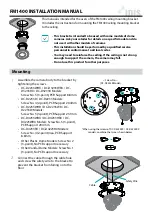
HTTP Port Configuration
Normally, HTTP (Web) connections use port 80. Since the Network Camera uses HTTP, but
port 80 is likely to be used by a Web Server, you can use a different port for the Network
Camera. This port is called the
Secondary Port
.
The default
Secondary Port
is 1024. If you prefer to use a different port number, you can
specify the port number on the Network Camera's
Network
screen.
See
Chapter 5 - Web-based Management
for further details on using the
Network
screen.
Viewers need to know this port number in order to
connect and view live Video, so you must inform
viewers of the correct port number.
DDNS (Dynamic DNS)
Many internet connections use a "Dynamic IP address", where the Internet IP address is
allocated whenever the Internet connection is established.
This means that other Internet users don't know the IP address, so can't establish a
connection.
DDNS is designed to solve this problem, by allowing users to connect to your LAN using a
domain name, rather than an IP address.
To use DDNS:
1. Register for the DDNS service with a supported DDNS service provider. You can then
apply for, and be allocated, a Domain Name.
2.
Enter and save the correct DDNS settings on the
DDNS
screen of the Network Camera.
3. Operation is then automatic:
•
The Network Camera will automatically contact the DDNS server whenever it detects
that the Internet IP address has changed, and inform the DDNS server of the new IP
address.
•
Internet users can then connect to the camera using the Domain Name allocated by the
DDNS service provider.
















































